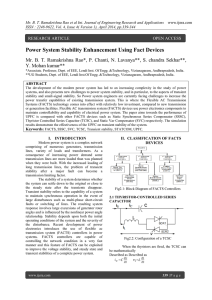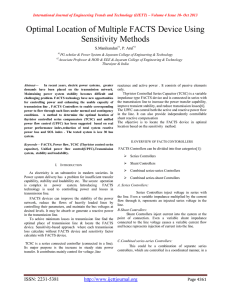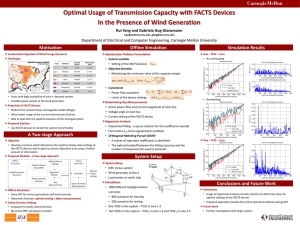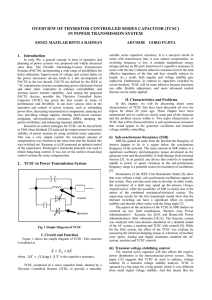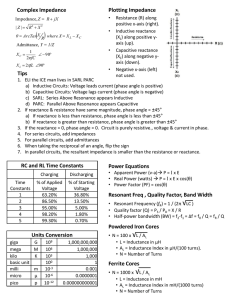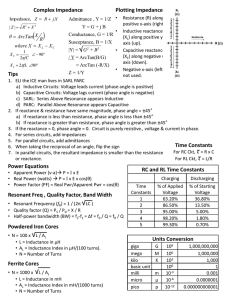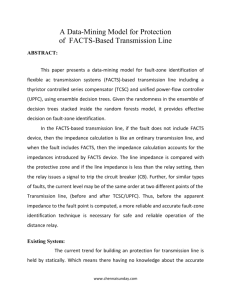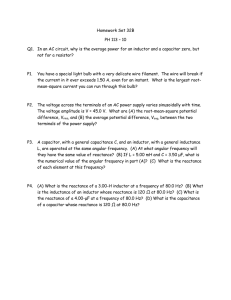Attaining Higher Reliability in Power Systems by Using Facts
advertisement
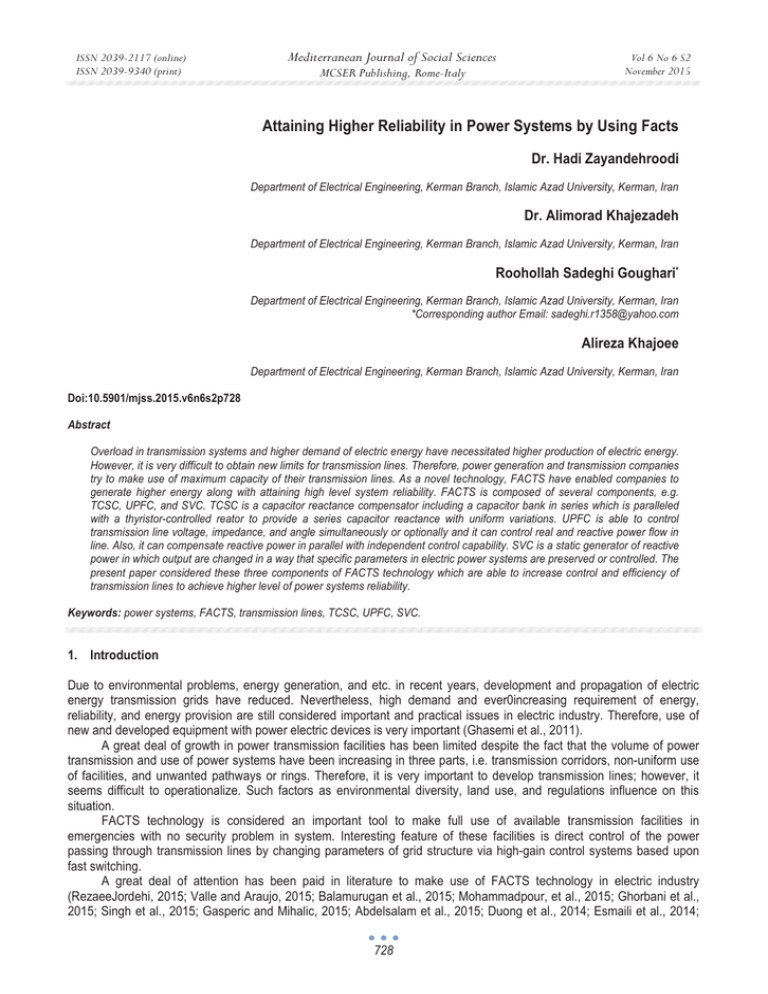
ISSN 2039-2117 (online) ISSN 2039-9340 (print) Mediterranean Journal of Social Sciences MCSER Publishing, Rome-Italy Vol 6 No 6 S2 November 2015 Attaining Higher Reliability in Power Systems by Using Facts Dr. Hadi Zayandehroodi Department of Electrical Engineering, Kerman Branch, Islamic Azad University, Kerman, Iran Dr. Alimorad Khajezadeh Department of Electrical Engineering, Kerman Branch, Islamic Azad University, Kerman, Iran Roohollah Sadeghi Goughari* Department of Electrical Engineering, Kerman Branch, Islamic Azad University, Kerman, Iran *Corresponding author Email: sadeghi.r1358@yahoo.com Alireza Khajoee Department of Electrical Engineering, Kerman Branch, Islamic Azad University, Kerman, Iran Doi:10.5901/mjss.2015.v6n6s2p728 Abstract Overload in transmission systems and higher demand of electric energy have necessitated higher production of electric energy. However, it is very difficult to obtain new limits for transmission lines. Therefore, power generation and transmission companies try to make use of maximum capacity of their transmission lines. As a novel technology, FACTS have enabled companies to generate higher energy along with attaining high level system reliability. FACTS is composed of several components, e.g. TCSC, UPFC, and SVC. TCSC is a capacitor reactance compensator including a capacitor bank in series which is paralleled with a thyristor-controlled reator to provide a series capacitor reactance with uniform variations. UPFC is able to control transmission line voltage, impedance, and angle simultaneously or optionally and it can control real and reactive power flow in line. Also, it can compensate reactive power in parallel with independent control capability. SVC is a static generator of reactive power in which output are changed in a way that specific parameters in electric power systems are preserved or controlled. The present paper considered these three components of FACTS technology which are able to increase control and efficiency of transmission lines to achieve higher level of power systems reliability. Keywords: power systems, FACTS, transmission lines, TCSC, UPFC, SVC. 1. Introduction Due to environmental problems, energy generation, and etc. in recent years, development and propagation of electric energy transmission grids have reduced. Nevertheless, high demand and ever0increasing requirement of energy, reliability, and energy provision are still considered important and practical issues in electric industry. Therefore, use of new and developed equipment with power electric devices is very important (Ghasemi et al., 2011). A great deal of growth in power transmission facilities has been limited despite the fact that the volume of power transmission and use of power systems have been increasing in three parts, i.e. transmission corridors, non-uniform use of facilities, and unwanted pathways or rings. Therefore, it is very important to develop transmission lines; however, it seems difficult to operationalize. Such factors as environmental diversity, land use, and regulations influence on this situation. FACTS technology is considered an important tool to make full use of available transmission facilities in emergencies with no security problem in system. Interesting feature of these facilities is direct control of the power passing through transmission lines by changing parameters of grid structure via high-gain control systems based upon fast switching. A great deal of attention has been paid in literature to make use of FACTS technology in electric industry (RezaeeJordehi, 2015; Valle and Araujo, 2015; Balamurugan et al., 2015; Mohammadpour, et al., 2015; Ghorbani et al., 2015; Singh et al., 2015; Gasperic and Mihalic, 2015; Abdelsalam et al., 2015; Duong et al., 2014; Esmaili et al., 2014; 728 Mediterranean Journal of Social Sciences ISSN 2039-2117 (online) ISSN 2039-9340 (print) MCSER Publishing, Rome-Italy Vol 6 No 6 S2 November 2015 Kumar and Kumar Mittapalli, 2014; Manahov and Hudson, 2013; Ravi and Rajaram, 2013 among others). The present paper aimed at determination of three important components of FACTS devices, i.e. TCSC, UPFC, and SVC. Also, a brief comparison of TCSC and UPFC in terms of their influence on power system reliability is provided. 2. Thyristor Controlled Series Capacitor (TCSC) TCSC is one component of FACTS which makes it possible to change apparent characteristic impedance in transmission lines so that power flow passes through conventional pathway. This controlled impedance can be programmed in a way that it can react in a distinct method in emergencies and increases power system security. As a result, it becomes possible to make consistent use of what system tends to in higher power levels. Although mechanical switches, as a rule, can achieve these advantages, proven speed and reliability of thyristors lead to full benefit from final capacity of transmission system. TCSC in transmission system is adopted in order to balance natural load in two parallel transmission lines for maximum transmission capacity. Transmission active power depends on transmission line reactance as follows: ܲ ൌ ȁ௩ଵȁȁ௩ଶȁ ሺߪͳ െ ߪʹሻ Therefore, power transmission can be changed by adjusting impedance of grid series through thyristor controllers. TCSC is one of the most important thyristor controllers. Fig. 1 shows the basic circuit of a TCSC. This includes a capacitor along with a reactor controlled by thyristor. In practice, TCSC is launched in series with transmission line in order to obtain optimal apparent voltage and proper working features. Figure 1: The main circuit of a TCSC According to the variations in fire angle of thyristors ( )ܤor conductance angle (ı), this process may be modeled as a fast switch in accordance with the reactance related to power system. Fig. 2 depicts changes of X TCSC in terms of changes of ܤ. Compensation degree of the series is controlled by increase or decrease in thyristors’ conductance period and consequently, the current passing through TCR. The firing angle ܤof TCR is defined as the difference in electric angle between the positive voltage passing through zero and the current passing through zero. In <ܤ90°, there is no control over inductive current. Also, >ܤ180° is not permissible for thyristors because of limitation in thyristors symmetrical firing (Shahmoradi et al., 2012). As mentioned above, TCSC acts as a controllable reactance in transmission line. It includes a branch containing a capacitor bank and a parallel branch with a controlled thyristor and inductive bank and it rectifies reactance of transmission line by controlling inductive branch. TCSC reactance is obtained as follows: ்ܺௌ ൌ ഏ ಽ ሾଶሺగିఈሻାୱ୧୬ ଶఈሿିಽ Where ܤ, XC, and XL denote firing angle of thyristor, capacitor reactance, and inductive reactance, respectively. TCSC is placed in transmission line in series and it is related to reactance of transmission line as follows: ܺ ൌ ܺ ்ܺௌ For achieving a better modeling for TCSC in optimization, it is usually defined as follows: ்ܺௌ ൌ ்ݎௌ ൈ ܺ where r stands for compensation factor of TCSC and it varies based upon where exactly it is placed on transmission line ranging between -0.7 and 0.2. A schematic view of TCSC can be seen in Fig. 2. 729 ISSN 2039-2117 (online) ISSN 2039-9340 (print) Mediterranean Journal of Social Sciences MCSER Publishing, Rome-Italy Vol 6 No 6 S2 November 2015 Figure 2: A corresponding model of TCSC 3. Unified Power Flow Controller (UPFC) Basically, UPFC has two voltage source inverters and a common capacitor between them, and they are connected to grid in series-parallel by two transformers. Fig. 3 depicts general structure of UPFC. Figure 3: General structure of UPFC In order to determine UPFC, it is modeled in two ways, i.e. coupled model and decoupled model. The former is more complicated because Jacobian matrix should be corrected here whereas the latter can be easily entered into load dispersion algorithms without any need to correction or simplification of Jacobian matrix. In most literature, decoupled model has been adopted. Fig. 4 shows the structure of a decoupled model of UPFC. Figure 4: Decoupled model of UPFC 4. Comparing TCSC and UPFC Here, a comparison is made in order to find the differences between UPFC and TCSC in terms of their influence on system reliability. TCSC renders a fast control ability on active power in transmission lines. For performing this comparison, TCSC can be considered as a continuous varying capacitor whose impedance ranges in 0XGZc max. Controllable series capacitor impedance can reduce a part of inductive reactance in transmission line and decrease total impedance of transmission line and consequently, it can increase transmissible power. Increased transmissible power is a fixed percentage of transmitted power by uncompensated line in a given transmission angle. In other words, higher transmitted power in a small transmission angle is very lower than that in a big transmission angle. This is associated with the fact that TCSC is a series impedance and the compensated voltage by TCSC is dependent on transmission line current which is a function of transmission angle į. In contrast, UPFC is a voltage source and compensated voltage by UPFC is not dependent on line current and į angle; it is dependent on maximum series voltage by UPFC. Here, it is assumed that TCSC is connected to the transmission line L1 in series. Compensation angle is in such a way that total inductive reactance of line L1 equals half of inductive reactance of L2. Moreover, it is assumed that reliability of TCSC and UPFC is 100%. It is considered that by reducing transmission angle and using TCSC, transmitted power from the lines L1 and L2 are 1.5P and 0.75 P, respectively(Abazari et al., 2009). Other system parameters are considered 730 ISSN 2039-2117 (online) ISSN 2039-9340 (print) Mediterranean Journal of Social Sciences MCSER Publishing, Rome-Italy Vol 6 No 6 S2 November 2015 to be the same. Reliability related to two situations in shown in Fig. 5. Figure 5: TCSC vs. UPFC It can be seen from above figure that for a given load peak, system risk level (LOLE and LOEE) is higher for TCSC than UPFC. This is more obvious for higher load level. It is because UPFC can ensure higher transmission reliability in system. 5. Static Var Compensator (SVC) SVC consists of a TCR (reactive impedance in XL with a two-way valve-thyristor) parallel with a capacitor bank XC and it adjusts the voltage of connecting point to the grid as a parallel varying reactance by absorbing or producing reactive power. It is mostly applied to provide reactive power very fast and to support voltage. By controlling firing angle of thyristor, SVC is able to respond instantaneously (Abazari et al., 2009). A schematic of SVC is shown in Fig. 6. Figure 6: Schematic representation of FC-TCR (SVC) circuit Controllable part of TCR reactance, XV is derived as follows: ܺ ൌ గ ଶగିଶఈାୱ୧୬ ଶఈ where ܤis firing angle of thyristor. Effective susceptance B in TCR is achieved as follows: ܤൌ ೇ ା ೇ 6. Conclusion As a novel technology based upon power electronics, Flexible Alternating Current Transmission Systems (FACTS) provide an opportunity to control, stabilize, and elevate power capability in AC power systems. Transmission and distribution of electric energy are regarded as dynamic and growing aspects of power engineering. FACTS technology is not a single powerful technology but it is a set of controllers, each is able to control one or some system parameters in isolation or in combination with other controllers. A properly selected FACTS controller can 731 ISSN 2039-2117 (online) ISSN 2039-9340 (print) Mediterranean Journal of Social Sciences MCSER Publishing, Rome-Italy Vol 6 No 6 S2 November 2015 solve specific limitations of a given line or corridor. Since FACTS controllers supply applications of a basic technology, production of this technology might make use of basic technologies. System designer can base predictions on the basis of a developing scenario including mechanical switching devices and FACTS controllers. The transmission lines equipped with a combination of mechanical controllers and FATS can achieve its goals via a stepwise and proper investment. FACTS makes it possible to reach maximum potential capabilities of system by addition of powerful controlling systems to electric energy transmission grid and controlling system parameters. Needless to say that FACTS technology provide new opportunities to control power and increase operational capability of existing lines as well as new and promoted lines. It is noteworthy that FACTS technology is an empowering technology not a proper alternative for mechanical switches. Also, FACTS controllers are able to increase power system reliability, among its other advantages. References Abazari, S., Shahgholian, G., Ghenaati, O. (2009). Optimal selection and placement of FACTS devices to reduce losses in power grid by genetic algorithm. Majlesi Journal of Electrical Engineering, 3(1): 45-51. Abdelsalam, A.A., Gabbar, H.A., Sharaf, A.M. (2014). Performance enhancement of hybrid AC/DC microgrid based DFACTS.International Journal of Electrical Power & Energy Systems, 63: 382-393. Balamurugan, K.,Muralisachithanandam, R.,Dharmalingam, V. (2015). Performance comparison of evolutionary programming and differential evolution approaches for social welfare maximization by placement of multi type FACTS devices in pool electricity market.International Journal of Electrical Power & Energy Systems, 67: 517-528. Duong, T., Gang, Y.J., Truong, V.A. (2014).Application of min cut algorithm for optimal location of FACTS devices considering system loadability and cost of installation. International Journal of Electrical Power & Energy Systems, 63: 979-987. Esmaili, M.,Shayanfar, H.A.,Moslemi, R. (2014). Locating series FACTS devices for multi-objective congestion management improving voltage and transient stability.European Journal of Operational Research, 236(2): 763-773. Gasperic, S.,Mihalic, R. (2015). The impact of serial controllable FACTS devices on voltage stability.International Journal of Electrical Power & Energy Systems, 64: 1040-1048. Ghasemi, M., Roosta, A.R., Fani, B. (2011). Coordinated control of the first generation of FACTS equipment by using neural network in order to increase transient consistency in power systems. Intelligent Methods in Electric Industry, 3(9): 27-40. Ghorbani, A., Mozafari, B.,Soleymani, S.,Ranjbar, A.M. (2015).Operation of synchronous generator LOE protection in the presence of shunt-FACTS.Electric Power Systems Research, 119: 178-186. Kumar, A., Kumar Mittapalli, R. (2014). Congestion management with generic load model in hybrid electricity markets with FACTS devices. International Journal of Electrical Power & Energy Systems, 57: 49-63. Manahov, V., Hudson, R. (2013). Herd behaviour experimental testing in laboratory artificial stock market settings. Behavioural foundations of stylised facts of financial returns. Physica A: Statistical Mechanics and its Applications, 392(19): 4351-4372. Mohammadpour, H.A.,Ghaderi, A., Mohammadpour, H., Mohd. Hasan, A. (2015). Low voltage ride-through enhancement of fixed-speed wind farms using series FACTS controllers. Sustainable Energy Technologies and Assessments, 9: 12-21. Ravi, K., Rajaram,M. (2013). Optimal location of FACTS devices using Improved Particle Swarm Optimization. International Journal of Electrical Power & Energy Systems, 49: 333-338. RezaeeJordehi, A. (2015). Brainstorm optimisation algorithm (BSOA): An efficient algorithm for finding optimal location and setting of FACTS devices in electric power systems.International Journal of Electrical Power & Energy Systems, 69: 48-57. Shahmoradi, A., Shahgholian, G., FaniMohammadabadi, B. (2012). Improvement of consistency of power grid by using TCSC in transmission line. The 1st National Conference on Novel Ideas in Electrical Engineering, Islamic Azad University of Iran, Khurasgan, Iran. Singh, B., Mukherjee, V., Tiwari, P. (2015). A survey on impact assessment of DG and FACTS controllers in power systems. Renewable and Sustainable Energy Reviews, 42: 846-882. Valle,D.B., Araujo, P.B. (2015). The influence of GUPFC FACTS device on small signal stability of the electrical power systems. International Journal of Electrical Power & Energy Systems, 65: 299-306. 732

